#Professor Trager
Explore tagged Tumblr posts
Text
Me: I do not have a type!
Me:
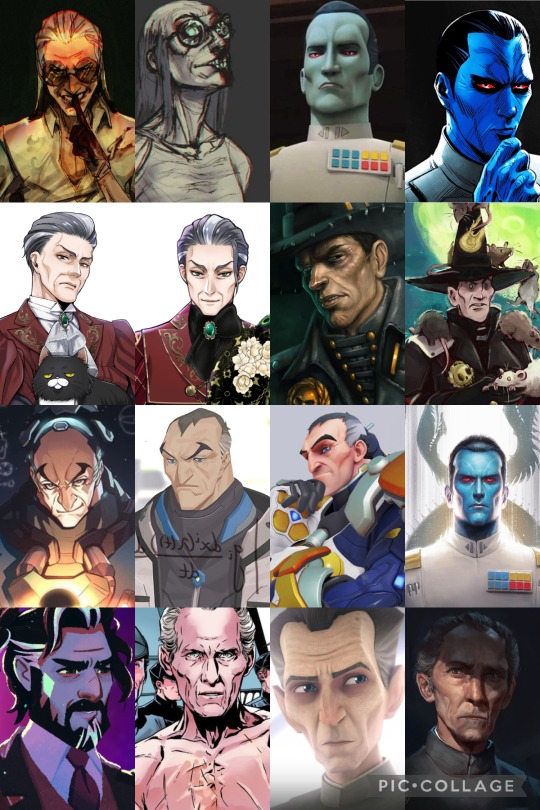
I may like old men with high cheekbones....
#mozus trein#wilhuff tarkin#richard trager#siebren de kuiper#victor saltzpyre#mitth'raw'nuruodo#professor shirazi
54 notes
·
View notes
Text
𝐄𝐓𝐂𝐋𝐎𝐔𝐈𝐄'𝐒 𝐀𝐔 𝐂𝐎𝐋𝐋𝐄𝐂𝐓𝐈𝐎𝐍



— back to navigation? or au works masterlist?

au - alternate universe; a reimagined version of a story where key elements are altered, creating a different setting or scenario — whereas you can find the below throughout my blog !!

THE WALKING DEAD
rick grimes — divorced dad!rick — undercover cop!rick
daryl dixon — mechanic!daryl — ex lover!daryl — motorcycle club!daryl — trailer park!daryl
negan smith — motorcycle club!negan — mob boss!negan
shane walsh — fwb!shane — mechanic!shane — jealous ex!shane — underground fighter!shane — crooked cop!shane — porn star!shane
CALL OF DUTY
john price — professor!price — porn star!price
simon ‘ghost’ riley — underground fighter!simon — bodyguard!simon — ex con!simon — neighbour!simon — roommate!simon — fake dating!simon
john 'soap' mactavish — single dad!soap — personal trainer!soap — fake dating!soap — rugby player!soap — ex!soap — porn star!soap
captian john 'soap' mactavish — retired!soap — sugar daddy!soap
kyle 'gaz' garrick — boxer!gaz — streamer!gaz — neighbour!gaz — footballer!gaz — porn star!gaz
phillip graves — sugar daddy!graves
CRIMINAL MINDS
aaron hotchner — dad's best friend!hotch — fbi training instructor!hotch — burnt out!hotch — ex!hotch — sugar daddy!hotch
derek morgan — personal trainer!derek — fake dating!derek
spencer reid — neighbour!spencer
luke alvez — neighbour!luke — mechanic!luke
emily prentiss — sugar mommy!emily
SONS OF ANARCHY
jax teller — divorced!jax — enemies with benefits!jax — ex!jax — porn star!jax
chibs telford — sugar daddy!chibs — retired!chibs — ex!chibs — bodyguard!chibs
juice ortiz — roommate!juice — gamer!juice — cam boy!juice
tig trager — sleazy landlord!tig — fwb!tig — jealous ex!tig
opie winston — divorced dad neighbour!opie
happy lowman — possessive ex!happy
THE MARAUDERS
james potter — footballer!james — roommate!james — professional quidditch player!james — single dad!james — ghost!james
sirius black — rockstar!sirius — tattoo artist!sirius — assassin!sirius — roommate!sirius — single dad!sirius — biker!sirius — ex!sirius
remus lupin — bookshop owner!remus — dealer!remus — perv roommate!remus
HP/SLYTHERIN BOYS
harry potter — ex!harry
ron weasley — drummer!ron
fred weasley — boyfriends brother!fred
george weasley — porn star!george
draco malfoy — arranged marriage!draco
blaise zabini — ex!blaise — porn star!blaise
mattheo riddle — brothers best friend!mattheo — ghost!mattheo — bodyguard!mattheo **archived — apocalypse leader!mattheo — arranged marriage!mattheo
theodore nott — teen dad!theo — arranged marriage!theo — mechanic!theo — dealer!theo — tradie!theo
lorenzo berkshire — porn star!enzo
MISC
lip gallagher — college!lip — roommates boyfriend!lip
READER
twd reader au's — paramedic/doctor!reader (rick grimes)
cod reader au's — grief therapist!reader (john price)
criminal minds reader au's — assistant!reader (aaron hotchner) — pre school teacher!reader (spencer reid) — florist!reader (spencer reid) — vet!reader (luke alvez)
soa reader au's — babysitter!reader (jax teller) — patched in!reader (jax teller) — club photographer!reader (jax teller) — teacher!reader (jax teller) — therapist!reader (jax teller) — club medic!reader (jax teller) — club lawyer!reader (jax teller) — street racer!reader (jax teller) — single mum!reader (chibs telford) — mechanic!reader (chibs telford) — stripper!reader (tig trager) — bartender!reader (juice ortiz) — single mom!reader (happy lowman)
marauders reader au's — wag!reader (james potter) — princess!reader (james potter)
misc reader au's — singer!reader (lip gallagher) — art major!reader (lip gallagher)

➜ ┊: heart divider by @strangergraphics ᵎ ✰
© 2025 etclouie. I do not condone reposting, plagiarising or translating my work in any form. my blog is 18+, strictly no minors !!
#— navigation#etclouie for my writing#multi fandom blog#au list#twd#cod#criminal minds#sons of anarchy#marauders#harry potter#slytherin boys#shameless#requests are open#au ideas welcome#twd au#cod au#criminal minds au#soa#soa au#marauders au#slytherin boys au#shameless au#reader au#sons of anarchy au
45 notes
·
View notes
Text
Onyx Storm RECAP ch19-ch21
Alright, activate Quest Mode...
Who is on the journey to retrieve the citrine? Violet, Xaden, Mira, Aura Beinhaven, Grady, others we don't care about.
WTF is the citrine? It’s a non-precious gem, yellow-brown, the kind of crystal you find in a hippie shop alongside tarot cards. They are mined in Poromiel & each griffin flier receives one at graduation. The one they’re retrieving belonged to the first griffin flier. Violet is going to give it to the king of Deverelli, who collects rarities, in exchange for a meeting.
WTF is happening in ch19?
Quest squad is flying over the border and outside the wards. Violet feels the wild magic outside the wards and has the urge to pull threads of magic from the sky around her. (Hmm)
Andarna stayed behind the wards. We learn that dragons & riders can't be far apart for extended periods of time. After 12 hours there will be pain for the rider; after 3 or 4 days there will be death.
They arrive in Anca, which has been drained & desiccated by venin. As long as nobody channels magic, they should be invisible to the enemy. The mission goes to shit when Aura freaks out at the sound of a door opening. She wields fire (uh-oh) and toasts Grady to death (um, fine?). Then the venin attack. Aura gets killed by a wyvern trying to evacuate.
Thanks to Mira they got the citrine, but the mission was a clusterfuck. Theophanie left a note for Violet with the citrine, which means she's a step ahead of them already.
WTF is happening in ch20?
Violet is in research mode. She's reading tons of books and connecting the dots on her dad's work, but she's not telling us (the readers) much yet.
Ridoc confronts Violet about wanting to join the next iteration of Quest Squad. He tells her when Violet is separated from her squad, that's when bad things happen to her. He also does a creepy cool thing of freezing all the water in an orange he's holding, which feels like foreshadowing of JfB's doom.
Violet meets with the Senarium and other assorted assholes (Halden, Aetos, Markham). The Senarium has new, annoying demands like putting Anna in control of the mission and allowing Markham & Melgren to search Aretia for "clues." (Creeps!)
Violet shuts it all down and demands control of the mission on the authority of her dragons & the Empyrean. Halden grants her permission to choose her squad for the next mission but threatens to negate the Aretia Accord (that gave Xaden his title) if she fails.
The assembled group hates Violet's choices, especially Xaden but also the Cordella fliers. Duchess of Morraine is trying to marry her daughter to Xaden. (Bitch)
Xaden tells Halden he's not the boss of him, that he only asks permission of "one person on the Continent" and looks to Violet. Tremendous Wife Guy energy and also direct rebellion against Haldon LOL. Violet & Xaden are gonna do whatever they want and it's obvious no one can stop them.
Mira meets Drake Cordella and immediately knees him in the balls. I can't wait for these two idiots to hook up.
While Violet has been reading her dad's journal, Mira has been reading Lilith's journals (interesting).
Who is going on the mission to Deverelli? Violet, Xaden, Mira, Ridoc, Cat, Drake, Halden, Anna (his guard), Trager (another griffin flier), and Dain Aetos.
WTF is happening in ch21?
Quest squad arrives in Cordyn. The griffins are carrying Halden & Anna in baskets??!!! There is no way this isn't absolutely fucking ridiculous looking. Violet is carrying something in a special pack that she leaves with Tairn.
Rooms are in short supply at Tecarus's mansion, and Xaden baits Halden into denying that he has any authority as a professor here, so Xaden can take an exhausted Violet into his room to sleep. There are several moments here where Xaden is reading Violet's mind (???), but she thinks she's talking down the wrong bond or talking out loud because she's exhausted. Methinks he's no longer simply reading "intentions" (and Violet agrees) but who knows!
Tecarus takes Halden & Anna by boat to Deverelli, so the riot can follow after some rest.
As Violet & Tairn fly over the ocean, the loss of magic begins to weaken the dragons and prevent them from "talking" to each other. Violet can no longer speak to Xaden through their bond, but she can still speak to Tairn & Andarna.
10 notes
·
View notes
Text
Onyx Storm spoilers - Malek's dirty little sticky fingers edition
Maren's parents :( The two little twin boys must be so traumatized, that was a very very sad loss even if we don't really see much of Maren.
Professor Grady, you're not remarkable at all and your death was funny as fuck - IDK why but I laughed hard.
Aura... I'm glad you're fucking dead, bitch.
Trager's death hurt because of the bluntness and also uneasiness of it. It was sudden, somewhat expected because it seemed too easy of a test... and it hurt. Specially when his gryphon tried so hard to reach him but died before she could do it. THEY HAD TO THANK HIS DEATH...Cat was also finally starting to involve herself with him...His death got me.
Halden's captain/mistress death was brutal, I felt bad for the girl. Dying because the prince is a little shit.
REBECCA STOP SCARING ME WITH RIDOC BEING STABBED WTF THIS MAN ALMOST DIED TWICE I CAN'T. VIOLET'S HEART CAN'T TAKE IT AND NEITHER MINE
Queen Mayara dying off screen was offensive. She served cunt with one scene. Rest in peace my queen, you will be missed
WHY DID YOU HAVE TO GET MIRA SO CLOSE TO DEATH NOOOOO ARE YOU OUT OF YOUR MIND????????? WHAT THE ACTUAL FUCK NOT MY WIFE!!!!!!
Quinn :( not that she was so present to give a big impact, but my heart broke for Imogen. She loved Quinn a whole lot and Quinn leaving a message for her girlfriend...one more love pair destroyed.
RIP Xaden's soul. No commentary on that because this man never ceases to suffer and- FORGET IT
12 notes
·
View notes
Text
CLAUDIO MICALIZZI on Pain
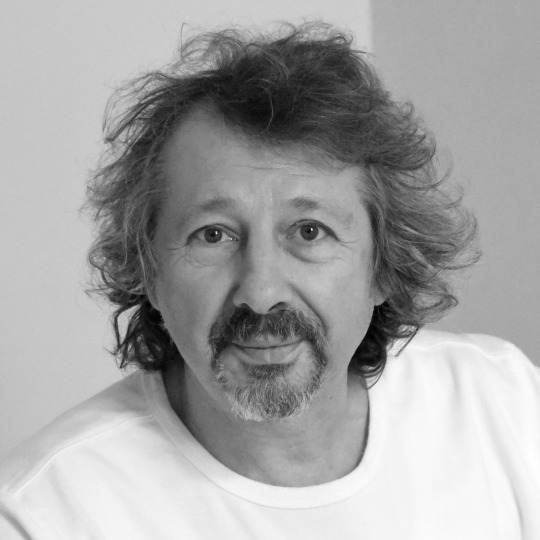
Claudio Micalizzi è professionista e insegnante di shiatsu con riconoscimento della FISIEO, iscritto al registro operatori e insegnanti. È direttore didattico della Scuola AnMa e ha una vasta formazione professionale che spazia dalla medicina tradizionale cinese al Tui-Na, dal metodo Trager alle tecniche di presenza corporea sensibile. Uno dei suoi contributi più significativi è l'ideazione della tecnica di shiatsu sul lettino chiamata "MaKeShi"®, che rappresenta l'evoluzione dello studio e della ricerca continua sullo "Shiatsu-Spontaneo" e sulla manualità intuitiva. Le sue altre attività e interessi includono la psicomotricità espressionale del professor M. Marteau, il massaggio sonoro con le campane tibetane di Albert Rabestain, la ricerca costante sul lavoro corporeo, espressivo e spontaneo, la pratica della meditazione naturale come ricerca personale di una spiritualità nel quotidiano. La sua variegata formazione e la sua costante e curiosa attenzione nel campo del benessere e della spiritualità sono i pilastri su cui si basa il suo lavoro e la sua pratica.
0 notes
Text
Don't mind me, I'm just leaving myself some inspo and notes to myself:
Tig Trager
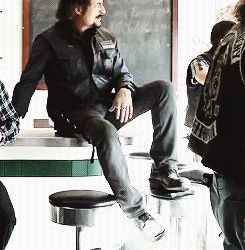
As a college professor

Teaching English lit { After the lava incident nobody dares to be late for his class, nobody. And the discussions are marvelous train wrecks}

AND creative writing {"Ok, you little ducklings. Writing a sensual love scene has nothing to do with repeating the words -hot- and -cum- a million times."}

Enter a snarky student and wait for the cliche yet very satisfying shenanigans to commence {“Christ, what a cliche. College professor getting blown in his office by a student.” "Do you want me to stop?" "Only if it's too much for you, Clever Girl" }
43 notes
·
View notes
Text
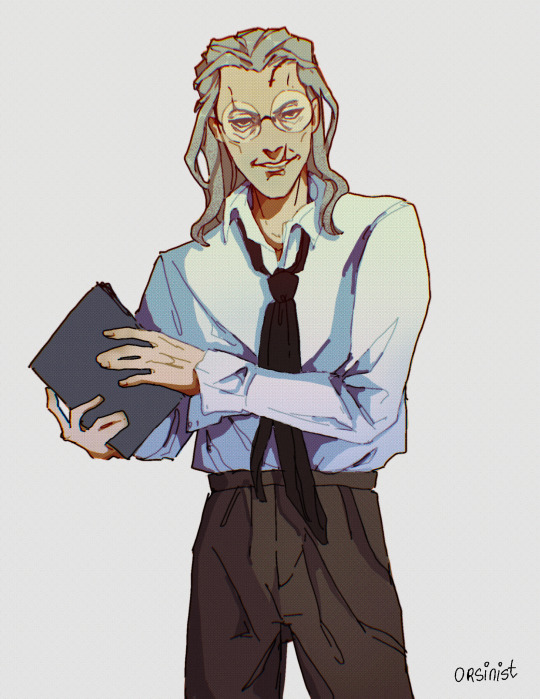
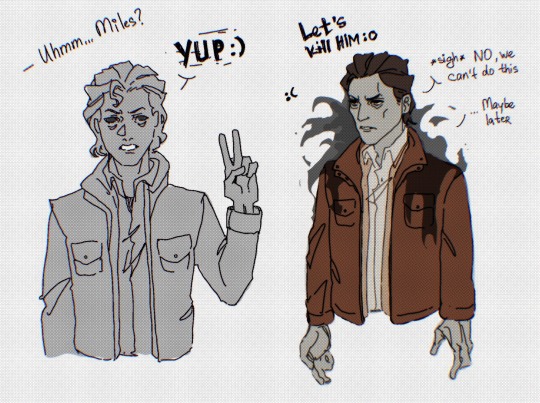
Economics professor Trager and Walrider!Miles
Btw I have 3 headcanons about Walrider!Miles and I can’t choose which one I like more: collective mind (Walrider and Miles became one entity which refers to itself as “we”), split personality and “Venom like”. What do you think about Walrider!Miles in general? 🤔
297 notes
·
View notes
Text
The Outlast College AU: the cast
Eddie Gluskin:
Eddie Gluskin (also known as "Ed" or "the groom" in a mocking way) is a failed pre-med student who switched over to fashion design and merchandising and is known for his "retro" style of dress along with his misogynistic behavior. He is a social outcast due to how he acts so despite his good looks and "charming" personality, he seldom ever gets dates or even respect from his other peers (functionally making him an incel). He is "friends" with Frank (although this is mostly just because Frank also happens to live with him) and that is really about it. And despite his bizarre standards for women and beliefs surrounding sexuality: he is dating Val who is the polar opposite of all of what he holds dear.
Frank Manera:
Frank Manera is Eddie's weed-smoking, whisky-drinking, grunge music-loving culinary school dropout roommate. Unlike Eddie, he is a social outcast by choice and actively chooses not to socially engage with other people or things. Frank is probably the most easy-going person you might meet partly due to the fact he is high all the time but also due to his "I really do not give a shit" attitude he has about practically everything. If it is not about his pickup truck, guns, food, weed, or the bands he likes he could care less. Frank is also occasionally seen at Crust-punk bars and other hole-in-the-wall places around MMU despite not being a student.
Val:
Val is a former member of the hyper-religious cult Temple Gate who once held the role of being the "mother" of all of the bastard children of its leader, Knoth, along with the orphans. She was unable to biologically produce children (functionally be a broodmare) so she took on the role of raising them instead. Val escaped the cult when she was 17 and attempted to bring others with her but was unable to. After her escape, she began to hyper-indulge in sex, drugs, body mods, and all of the other things she was never allowed to even talk about while living on the commune. She never got an education and instead opted to continue partying while also taking a job at a Spencers near MMU. She is dating Eddie Gluskin for reasons not fully understood. And despite her new life of freedom and indulgence, she is still on the run from the cult who does periodically attempt to drag her back. She still misses some members of the cult, specifically the children she cared for and wanted to take with her, but also deeply fears being dragged back too much to do anything.
Miles Upshur:
Miles is a journalism student at MMU who also works at the Spencers with Val. He is yet another stoner similar to the likes of Frank only with a significantly more conspiratorial slant. He is best friends with Waylon Park and frequently pulls him into his strange schemes and ventures (like when he goes ghost hunting in abandoned asylums or attempts to prove aliens exist). And much to his friend's horror: he overall lacks a sense of self-preservation and self-control which frequently results in him getting into a lot of dangerous situations.
Waylon Park:
Waylon Park is a computer science major at MMU and the unwitting best friend/accomplice of Miles. He is a lot more timid than his best friend and spends most of his time locked in his apartment streaming video games or working on various coding projects and actively avoids danger/confrontation. He is dating Lisa, a literature major, and is in a pretty steady relationship with her. Due to his more ambiguous appearance, he was mistaken for a woman and thus pursued by Eddie but that was quickly shut down when the truth was revealed and a restraining order was filed.
Rick Trager:
Rick Trager is an extremely shifty business professor teaching at MMU who may or may not be addicted to cocaine. The only reason he has not been fired is due to his tenure at the university.
Jermey Blaire:
Trager's equally as shifty/douchy TA who practically models himself after Patrick bateman.
Chris Walker:
Chris Walker is a former combat veteran going back to school after his time in the service. His exact major is unclear as it has changed several times. But due to his emence size and overall strength he is also a coveted member of the MMU football team. Chris does not have a particularly close relationship with anybody and only happens to know Miles because he had a class with him once (and in turn grew to dislike him as he came off extremely annoying).
Blake Langermann:
Blake is a fellow jornalisim major along with Miles and is a catholic school survivee. Blake is only mildly acquainted with the likes of Miles and Waylon and instead focuses a majority of his time on working on projects with his girlfriend Lynn who is also a journalism major. These projects are usually Exposes regarding local controversies or drama going on (along with the periodic serious human rights/civil rights violation). However, he will join Waylon and Miles on their bullshit adventures from time to time.
Father Martin:
He is the weird guy standing outside of MMU with a large sign only instead of telling people they are going to hell, he warns of the end times and weird ghost demons coming but it is unclear if he is for or against them.
Sullivan Knoth:
Is the leader of the Cult Val escaped from and one of the main antagonists in Val's life. He is functionally the same compared to how he is in the game minus the radio tower frequencies: he is just crazy naturally.
Marta:
Is funtionally the "Sister Cindy" of MMU. She, unlike Father Martin, does accuse all of the students of being whores and tells them they will burn in hell if they don't repent (and do so to Knoth's teachings). She is also the closest immediate threat to Val's freedom and safety outside of the cult given she is still actively looking for her (dubbing her "the Heretic").
Ethan:
The only person from the cult Val is still somewhat in contact with. He is too attempting to escape given his fading faith had the fact Knoth sexually assaulted his daughter and is denying his wife the ability to get cancer treatments as "only god can decide if she lives". He tried to leave with Val initially but had to stay behind in order to at least allow Val to escape and to protect his family.
Billy Hope:
Billy is a highschooler who has functionally adopted by the MMU football team and is "enrolled" at the school a year early so he can play football. His mother, Tiffany, more or less signed off on it due to the hefty sum of money she was offered to allow her son to play.
"The Twins":
Really creepy townies everybody avoids and can usually be spotted with Martin
Pauline Glick:
The asshole president of MMU who may or may not be taking bribes and doing a bunch of illegal shit along with Blaire and Trager
"Mother Gooseberry (Phyllis Futterman)":
Is a washed-up former children's TV host who later became an art teacher at MMU. She teaches several of the more "technical" arts classes such as sewing and technical drawing. However, she also teaches dental classes at MMU although not that many. It is unclear when or if she even got a degree in dental medicine. But given she is only teaching more "anatomy" based lessons and is not actually practicing medicine: it is looked over by MMU administration.
Leland Coyle:
The campus cop who is activly on a power trip, all of the time.
"The Pusher":
The guy who sells literally everybody drugs. Weed, coke, you name it, he has it.
#outlast#eddie gluskin#val#val outlast#frank manera#rick trager#jeremy blaire#waylon park#miles upshur#marta#sullivant knoth#chris walker#blake langermann#outlast college au#outlast au#college au outlast#mother gooseberry#leland coyle
116 notes
·
View notes
Text
F/O LIST (REDONE)

Those who are in bold are VERY close to me, meaning i think about them a lot and get happy seeing them! I’ll be sure to put those at the top.
ROMANTIC F/OS (Characters i’m romantic interested in & self ship with myself);
Wilhelm (Borderlands pre sequel/Borderlands 2),
Handsome Jack (Borderlands 2/Borderlands Pre sequel),
Dr. Habit (Smile For Me),
Mettaton (Undertale),
Karl Heisenberg (Resident Evil),
Skull/Bear/Sans (Horrortale),
Sniper (Tf4),
Jonathan Crane/Scarecrow (Batman),
Rick Trager (Outlast),
SCP-035 (SCP),
Pyramid Head (Silent Hill),
Arthur Hastings (We Happy Few),
Beelzebub (Obey Me!).
PLATONIC F/OS (Characters i see as friends/best buds! We just vibing);
Timothy Lawrence (Borderlands 3),
Blade (Puppet Master),
Spy (TF2),
Sir Didymus (Labyrinth),
Rhys Strongfork (Borderlands 3/TFTB),
Vaughn (Borderlands 3/TFTB),
SCP-049 (SCP).
FAMILIAL F/OS (Characters i see as family! Bc comfort);
Sir Hammerlock & Wainwright Jakobs (Borderlands 3) - Fathers
Mordecai (Borderlands 2) - oldest Brother.
Elric Brothers (Edward & Al) - Oldest brothers.
Henry Emily (Blueycapsules) - Father.
Professor Venomous (OK K.O) - Father.
Fink (OK K.O) - Youngest sister.
#Redone the list bc the old one was outdated and i didn’t feel like going thru it#self ship#f/o list#self ship community
4 notes
·
View notes
Note
Just because we've both got outlast brain-rot going on and, let's be real, VA jokes are always hilarious, can I get either Rick Trager leading the charge in Little Hope, or John littlehope as the 'boss' variant in the male ward? Your choice.
“Andrew, Andrew, I - whoop, there you are...heyyy buddy, how you feeling?”
In the darkness behind his eyes, Andrew felt the cozening voice swirl around and around like snow in a snow globe, taking twice as long to make sense as it normally would’ve; he could remember...he could remember an awful dream, an unbearable heat on his face, and then...and then blackness. He opened his eyes with a grunt of pain and then just as quickly reeled back in surprise, pulling in a sharp breath. “Wh...who are you?”
There was a chuckle, nasally and not altogether friendly as the man (or thing that had once been a man) in front of him squatted down on his haunches, the ruin of his face made somehow infinitely worse by the magnifying lenses of his glasses, making his eyes look very much like the dark, soulless eyes of an undiscovered deep-sea species. “Aw, sounds to me like someone went and bumped their head, eh...” he chuckled, and maybe he was concussed but all doubt fled Andrew’s mind that it was not in any way, shape, or form a friendly sound, “I’m Rick, your professor, and you, pal, have lost a lot of blood.”
six sentence sat(or)sunday!!!
#love-fireflysong#asks#queenie writes supermassive#absolutely based on how i realized john was trager XD that opening 'hey buddy#i stg it triggered my fight or flight
4 notes
·
View notes
Text
F/o list
since I moved from quickly-sketched I don't have a list anymore here’s a new one !
Main baes
Pickles the drummer (metalocalypse)
Brook (soul king)
Varric Tethras (DA inquisition)
Antagonists
Ardyn izunia (ffxv)
Berkeley beetle (thumbelina)
Doflamingo (one piece)
general klytus (flash gordon)
Mr wheezy (cuphead)
Rothbart (swan princess)
Nnoitra (bleach)
lucas baker (re biohazard)
Scaramouch (samurai jack)
Professor Pester (viva pinata)
Balthazar Bratt (despicable me 3)
Ganondorf (oot)
en (dorohedoro)
Slashers/murderers in general
Michael Meyers (halloween)
Jason Voorhees(friday the 13th)
Pyramid head (silent hill)
Eddie gluskin (outlast)
Frank manera (outlast)
Kamui (b the beginning)
Jake Martinez (tiger and bunny)
Godbrand (castlevania)
Poly
Mayuri/me/Kenpachi (bleach)
Stronk
zebra (toriko)
The admiral (mhw)
Uvogin (hxh)
yami sukehiro(black clover)
alex louis Armstrong (fma)
Robot/monster/skeleton/etc
Beetlejuice
Cactus gunman (gregory horror show)
Six shooter (puppet master)
Gregory(gregory horror show)
Kululu (sgt frog)
Dedan (off)
pennywise 90s (it)
Draal (trollhunters)
Snow miser(ywasc)
Itward (fran bow)
Master joris (wakfu)
BOB (overwatch)
general grievous (star wars)
Crazy/smart/scientist/wizard
Dr Orpheus (venture bros)
algernop Krieger (archer)
M rasmodius (stardew valley)
rick sanchez (rick and morty)
Dr. F (my sims)
Richard trager (outlast)
The rest
Jiraiya (naruto)
Shane(stardew valley)
Iyami (osomatsu-san)
Cardinal Copia (ghost bc)
Papa emeritus II (ghost bc)
Nanu (pokemon sumo)
ace (gorillaz version)
sniper (tf2)
spiderman noir (spiderverse)
Ooshima kyotaro (gokusen)
Waluigi (mario franchise)
Yondu Udonta (gotg)
Az (pokemon)
Shadowsan (carmen sandiego)
Unsure of relationship
Hidan (naruto)
Kakuzu (also naruto)
Platonic
Guzma (pokemon sumo)
Rouxls kaard (deltarune)
Judgement boy (ghs)
Hell’s chef (ghs)
Buggy the clown (one piece)
Junkrat (overwatch)
Blade (puppet master)
Piers (pokemon swsh)
#my faves#f/o list#I really just copied off of my old one and skimmed for any minors I used to like when I was a minor#if i missed any please tell me so I can remove them#main baes are just baes I will always love#im love everyone here but they are in that cycle of hyperfixation and then forget and then hyperfixation#whereas the main baes are always in the back of my head#so yeah feel free to ask about my relationship with any of these lovelies
9 notes
·
View notes
Note
I'm 5'7" with medium brown hair and green eyes. I have anxiety, depression, Graves Disease, and ADHD. I love animals more than anything. I have a cat, two pit bulls, and would LOVE to foster. I am the mom friend. I am very honest - my face betrays any thought/feeling I ever have, so I have to be. I love video and board games, watching movies/TV shows (mostly sci-fi with a dash of cop and some reality), yoga, sketching, and painting. I'm studying to become an art professor. <3
Hello and welcome to the SHIP! So for you my lovely, I am going to hook you up with the one and only Tig Trager. I feel like Tig would understand and embrace your anxiety and depression while trying to learn everything he can about Graves Disease and ADHD so that he can help out when needed. He also has a love for animals so it’s safe to assume that you guys would have a house full and you’d give them all lots of love. When it comes to the rest of the club or to friends you offer loads of motherly advice and sometimes guide them out through their troubles. Your honesty is what draws Gemma and others in because they sometimes need it. Tig would enjoy playing video games and board games with you as well as watching movies and tv shows. He wouldn’t necessarily be into yoga, but he’d love watching you do yoga. In return you’d end up sketching him at random times mostly when he’s sleeping or working on his motorcycle. Tig would also be a huge supporter for your school work and education.
3 notes
·
View notes
Text
... 3am
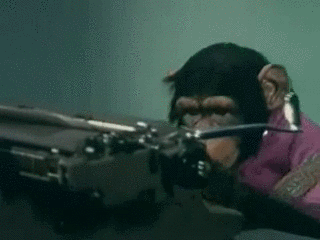
Today was a good writing day; for both SOA fanfic and Chaos worlds. Professor Trager is coming along nicely (and filthy at over 3,5k). Although he got kind of tied up for the time being as I played with combining some very potent requests I found in my ask box this morning (total word count ~3k).

And let me tease you just a bit 😉 Samcro party night, boys having sweaty, violent fun in the ring, Chibs' clever fingers at the picnic table, sweaty shirtless Tig, "It's gonna be that kinda night, huh?", "Lass is very adamant", "Hell, Doll, we could do this right here but I don't think you'd still like us in the morning", "Sshhh, Pet. Just feel us"
Now if only descriptions would start playing along...
Taking breaks from all the smut, I transcribed over 9k of handwritten notes for my original project. My fingers are about to fall off. Hope I'm gonna be at least half as giddy about it all in the daylight.
15 notes
·
View notes
Text
Esses Hormônios Interativa

♠ Nome e sobrenome:
Kim Jaehyun
♠ Apelido:
Hyun
♠ Idade:
18 Anos
♠ Aparência:


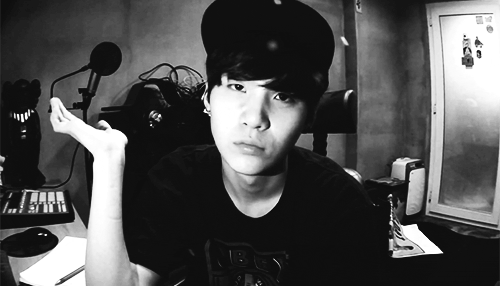
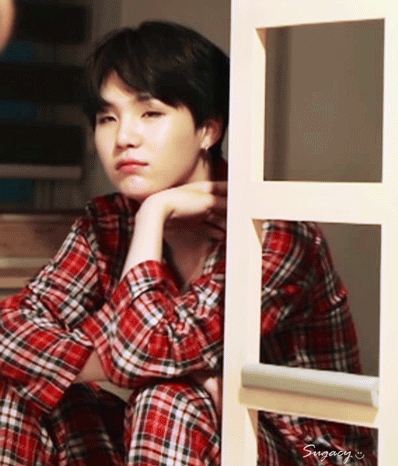
Jaehyun possui cabelos negros seus olhos são coloração de preto escuro sua pele é pálida tendo um altura baixo em media de 1.69cm seu físico magro pesando exatamente 49kg possuindo pouca massa muscular esta na forma certa para sua idade lábios rosados é nariz fino é rebitado .
♠ Photoplayer: Min Yoongi - bts
♠ Nacionalidade: Coreano
♠ Orientação sexual: Bissexual
♠ Personalidade: Jaehyun possui uma personalidade bastante calmo ele sempre visto com olhar sereno sendo uma pessoa reservado é tímido o mesmo não é muito de conversa com outras pessoas ao seu redor ele realmente só vai falar se alguém puxar assunto com ele muitos podem acabar entendo errado esse seu silencio achando que ele é arrogante é frio mas Jaehyunnão é ele só é pessoa quieta é tímido o mesmo só consegue realmente conversa se alguém puxar assunto com ele vai se sentir mas seguro é confortável para conversa com outros , sendo bem observador Jaehyun sempre esta em alerta com tudo que acontece ao seu redor nada passa de seus olhos sendo sincero ele sempre vai falar que pensa muitas vezes o mesmo acaba falando algo que possa magoar alguém quando isso acontece ele vai pedir desculpa por ter magoado não era sua intenção dizer algo ruim Jaehyun possui um lado bastante preguiçoso também o mesmo não gosta muito de atividades que envolve corridas ou caminhas ele tem grande preguiça que o impede de sair de sua areá de conforto tem que acontecer um milagre para Jaehyun realmente se interessar por algo ou chamar sua atenção ai o mesmo vai lá é faz Jaehyun possui um lado bem protetor em relação com suas amizades ele sempre esta disposto para proteger aqueles que ama ele não tem medo de sair com alguns arranhão para proteger aqueles que são importante para ele pode não parecer mas Jaehyun é bem ciumento em relação com quem ele gosta sendo tanto quanto grudento sempre querendo saber onde a pessoa vai com quem ele esta isso pode trager pequenas brigas Jaehyun já tentou mudar mas isso faz parte dele Jaehyun é bom amigo se conhecer ainda mas vera que ele é boa pessoa para todos os momentos sendo eles bons é ruins .
♠ História: Jaehyun veio de uma família de classe media deixe de pequeno ele teve uma infância normal todos os dias ele ia a escola com seu irmão mas velho Sook eles iam de mãos dadas para o mas novo não se perder do mas velho na escola Jaehyun tinha poucos amigos por ser um garoto quieto mas ele era bem inteligente tinha boas notas por causa disso isso foi atraindo pessoas ruim como valentão de sua escola que sempre ficava no pê do garoto fazendo bully Jaehyun sofria em silêncio porque tinha medo de apanhar , mas um dia esses garotos foram descoberto pelos professores por causa dos problemas que veio causando na escola assim sendo expulso Jaehyun nunca mas sobre Bully assim estudando normalmente quando Jaehyun foi crescendo ele foi para colegial escola um pouco melhor o mesmo não mudou muito ainda continuava sendo ele todos os dias Jaehyun se esforça para ser um lado ainda melhor quando o mesmo terminou a escola Jaehyun decidiu fazer um curso de informática é seguir o ramo de computadores já que esse seu maior sonho com isso ajudar também em casa é trager uma vida melhor para sua família.
.•*´¨`*•.¸¸.•*´¨`*•.¸¸.•*´¨`*•.¸¸.•*´¨`*•.¸¸.•
♠ Família:
Nome : Kim Geum 37 Anos professora

Geum é mulher de personalidade bastante gentil a mesma sempre vista com sorriso no rosto sendo uma boa mãe para seus filhos amigável com seus amigos Jaehyun possui uma boa relação com sua mãe ambos sempre visto conversa sobre diversos assunto ele sempre ajuda em casa quanto sua mãe esta trabalhando
♠ Photoplayer: Hyuna
Kim Daejung 38 Anos Policial

Daejung possui uma personalidade bem brincalhão o mesmo bem tranquilo ele bem mente aberta para as coisas mas também Daejung sabe ser serio como precisa Jaehyun é seu pai possui uma ótima relação ambos sempre saim juntos é falam sobre tudo um com outro Jaehyun gosta da companhia de seu pai sabe como o mesmo se esforça para fazer sua família feliz.
♠ Photoplayer: G- Dragon Big Bang
Kim Sook 21 Anos esta fazendo faculdade medicina

Sook sempre demostrou ser uma pessoa bem mas tranquilo é mas responsável sendo bem inteligente é amigável com pessoas mas próximas é protetor um pouco tímido Jaehyun é tem uma relação boa com seu irmão mas velhos ambos são bem unidos Sook sempre esta apoiando seu irmão mas novo deixe que ele era ainda pequeno Sook se sente um pouco culpado por não ter conseguido proteger na epoca de escola já que ambos estudava em escola diferente Jaehyun sempre fala para Sook esquecer já que aquilo já acabou é as coisas são diferente agora.
Photoplayer: hyunseong boyfriend
♠ Deseja par: Sim
♠ Gostos e Desgosto:
- ele gosta de ouvir música
- dias de frio
- de dormir atê tarde
- de assistir animes é doramas
- lugares com pouco barulho
- tocar violão
- torta morango
- ler livros
- ele não gosta violência
- de preconceito
- de ver seus amigos triste
- comida apimentada
- ele odeia verão
- tomate seco
- lugares muito escuro
- de ver animais sendo agredidos
♠ Manias: ele tem grande mania de morde os lábios quando esta nervoso
♠ Medos: ele tem medo de aranhas é bonecos
.•*´¨`*•.¸¸.•*´¨`*•.¸¸.•*´¨`*•.¸¸.•*´¨`*•.¸¸.•
♠ qual foi a reação do seu personagem ao saber que caiu no golpe? ele ficou bem espanto no começo demorou um pouco para reagir muito bem mas depois o mesmo ficou com raiva de ter caido no golpe
♠ o que ele pensa sobre morar com pessoas do sexo oposto? se ele for morar com Sexo oposto ele ficaria um pouco nervoso com isso
♠ Conseguirá esconder o segredo? sim conseguirá esconder o segredo
.•*´¨`*•.¸¸.•*´¨`*•.¸¸.•*´¨`*•.¸¸.•*´¨`*•.¸¸.•
♠Relações
♠ Kwan : No começou Jaehyun não conversa muito com Kwan era poucos diálogos que ele tinham no dia a dia com tempo Jaehyun foi se abrindo mas com Kwan assim se tornando um pouco mas social com ele se tornando um mas brincalhão é mas comunicativo com o Kwan.
♠ com outros moradores : Jaehyun por ser uma pessoa tímido ele não era muito de falar com os outros moradores ele só falava mesmo quando alguém o chamava mas com passar do tempo de convimento Jaehyun vai aprender a ser mas falante é atê mesmo mas brincalhão com os outros moradores .
♠ Par : ele bem carinhoso com par sendo bem protetor sempre esta se esforçando para fazer seu par feliz tanto quanto ciumento também Jaehyun mesmo tentando mudar esse seu lado ele não consegue por causa disso pode trager pequenas brigas entre ele é par mas Jaehyun ira se esforçar mas é mas se for para ver seu par sorrindo ele ira se esforçar para tira esse seu lado ciumento custe que custar.
♠ Inimigos: ele não liga muitos para seus inimigos sempre sendo bem frio em relação a eles .
♠ Vizinhos: ele tenta ser bem amigável com os Vizinhos é trata com respeito é gentileza .
♠ Desconhecidos: Jaehyun não é muito em confiar em Desconhecidos o mesmo sempre fica com um pé a trais como vai falar com um.
.•*´¨`*•.¸¸.•*´¨`*•.¸¸.•*´¨`*•.¸¸.•*´¨`*•.¸¸.•
♠ Favoritou ? sim favoritei
♠ Irá comentar em todos os capítulos ? irei comentar em todos os capitulos
♠ Está ciente que seu personagem pode não ser escolhido ? sim estou
♠ Algo Mais ? Nop
1 note
·
View note
Text
Chapter Five: Libel
For my attempt at communication law, I will be utilizing a book titled “The Law of Journalism and Mass Communication” in order to complete chapter outlines.
Topic Overview:
The defense of libel can come in several different forms and varies throughout the United States of America. There are some states which have implemented anti-SLAPP legislature to protect against inhibiting speech through libel claims. Journalists often exercise greater rights to report on government functions, and greater leeway for their opinions. However, the defense of opinion must pass the four step Ollman test to be considered non-libelous. For defending libel in a general sense, the principal idea used is the concept of believably. If the statement cannot be proven as both true and believable, there cannot be a charge. This often protects satire, hyperbole, and even private blogs. Various states do have limits to jurisdiction, statute of limitations, and retractions which potentially assist a defendant accused of libel.
Defining key terms: Considering that this is an outline rather than a complete summarization of chapter five, I have strictly selected key terms I had not encountered prior to reading. These key terms include:
SLAPP (Strategic Lawsuit Against Public Participation): A lawsuit whose purpose is to harass critics into silence, often to suppress those critics’ First Amendment rights.
Fair comment and criticism: A common law privilege that protects critics from lawsuits brought by individuals in the public eye.
Neutral reportage: In libel law, a defense accepted in some jurisdictions that says that when an accusation is made by a responsible and prominent organization, reporting that accusation is protected by the First Amendment even when it turns out the accusation was false and libelous.
Retraction statutes: In libel law, state laws that limit the damages a plaintiff may receive if the defendant had issued a retraction of the material at issue. Retraction statutes are meant to discourage the punishment of any good-faith effort of making a mistake.
Important cases:
Ollman v. Evans (1984): This is a case regarding libel, where professor Bertell Ollman was offered a new position at the University of Maryland. However, two journalists published an article regarding Ollman, which led to his position offer being withdrawn by the university. Ollman then sued the journalists for libel, claiming that it damaged his reputation and caused him distress. The Court ruled in favor of Ollman, stating that the article written by the journalists were not of pure opinion. Of this ruling came the ‘Ollman Test’ for opinion.
Milkovich v. Lorain Journal Co. (1990): Another libel case, a wrestling coach (Michael Milkovich) was accused of lying at a hearing he attended in an article written by journalist Theodore Daidium. Milkovich then sued Daidium for libel, claiming that the article accused him of false claims. The Court ruled in favor of of Lorain Journal Co. (Daidium’s employer), stating that there was a failure to show malice in the case, and was therefore protected under the First Amendment. However, the Ohio Court of Appeals reversed and remanded prior decisions, stating that the statements were not protected opinions based on Milkovich’s lack of public recognition. Overall, the Court ruled in favor of Milkovich.
Relevant Doctrine:
Chapter one defines doctrine as “principle or theories of law that shape judicial decision making.”
Libel Defenses: A libel defendant wants to strengthen his or her position by showing as many of the following as possible:
1) the story was investigated thoroughly
2) interviews were conducted with people who had knowledge of facts related to the story, including the subject of the report
3) previously published material was not relied on
4) biased stories were not relied on
5) the reporting was careful, systematic and painstaking
5) multiple viewpoints were sought and, when possible, included in the report
6) there was a willingness to retract or correct if facts warranted such action
7) if applicable, there was a demonstrable deadline
8) there was no ill will or hatred toward the plaintiff
In addition to defending a libel case on the elements, those accused of libel have several defenses at their disposal that may not directly correspond with any element of the plaintiff's case.
The Ollman Test for Opinion:
1) verifiability
2) common meaning
3) journalistic context
4) social context
Current Issues or Controversies:
If anyone has been watching the USA news recently, they may recall the story that broke out and eventually went viral regarding a group of Convington High School students at the Lincoln Memorial. Several media outlets claimed that he and other students in the group were taunting a Native American man. More specifically, articles called the star of the incident (who was filmed), Nicholas Sandmann, a racist who started the encounter with the man (arguably due to the MAGA hat he and the students were wearing). As a result, he and his family hired Georgia attorney Lin Wood to sue the media for libel. Considering what I have learned in this chapter, perhaps he does have a case.
My Questions / Concerns:
1) Does Washington State use the term ‘libel’, or a different term? I did not encounter the same terminology while studying local cases. If it is a different term, why is that?
2) How long does it typically take to settle a libel case in court, for both the typical cases and those which rarely make it to the US Supreme Court?
3) For those like Nicholas Sandmann, how does one approach desiring to sue different media outlets? Is it all in one suit, or will they need to file separate suits?
References:
Trager, Robert F., et al. The Law of Journalism and Mass Communication. CQ Press, 2018.
Thanks for coming to my Ted Talk!

0 notes
Text
Thank you!
oneshots (they keep growing, tho) or series // enemies to lovers or friends to lovers // quick burn or slow burn (but depends on the premise) // reader insert or original character (currently experimenting with reader)// angst or fluff ( Mindfucks is the hill I will die on) // mutual pining or unrequited love // love triangle polyfidelitous throuple or fake relationship // in vino veritas or sharing one bed // dark fic or soulmate au // fairytale au or arranged marriage // bang or die or sex pollen // hurt/comfort or unhappy ending // coffee shop au or college au (but only because of Professor Telford and Professor Trager) // porn w/ plot or porn w/o plot
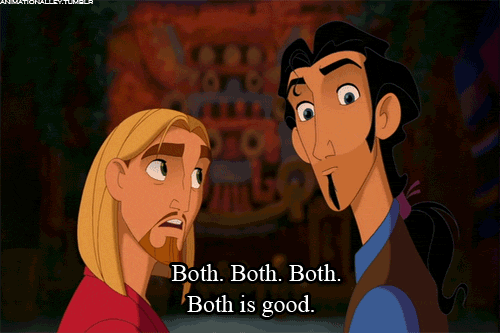
No pressure tags:
@the-anonymous-pen @dallianceangel @gillysoldlady
oneshots or series // enemies to lovers or friends to lovers // quick burn or slow burn // reader insert or original character // angst or fluff // mutual pining or unrequited love // love triangle or fake relationship // in vino veritas or sharing one bed // dark fic or soulmate au // fairytale au or arranged marriage // bang or die or sex pollen // hurt/comfort or unhappy ending // coffee shop au or college au // porn w/ plot or porn w/o plot
No pressure tags: @massivecolorspygiant @nocturnal-milk-dud @jadore-andor @magpie-to-the-morning @cheesybadgers @a-bang-for-your-bucky and anyone else!
76 notes
·
View notes